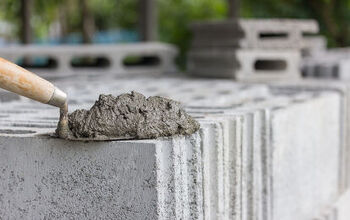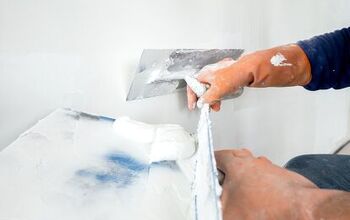Quikrete Vs. Portland Cement: What Are The Major Differences?

Whether you’re setting fence posts, building a foundation slab for a home, creating stucco, or DIYing some hypertufa pots, you may need to know the difference between Quikrete and Portland Cement, and when to use one over the other. Quikrete is a brand name that is famous for its fast-setting, pre-mixed concrete that comes in bags. These bags provide a convenient alternative to regular concrete, as you just add water and mix.
On the other hand, Portland cement is the most popular form of cement out there. It comes in a fine powder and is one of the most basic ingredients found in concrete. Without cement, you cannot have products like Quikrete. Very few things in the world are composed of just cement. Whereas, concrete, can be found virtually anywhere.
To help you understand Quikrete vs. Portland Cement, we’ve compared them side by side to describe the most important differences between the two.
Do You Need Concrete, Brick, or Stone Pros?
Get free, zero-commitment quotes from pro contractors near you.

Concrete vs. Cement
Before we dive deeper into the difference between Quikrete and Portland cement, it’s important that you understand the difference between concrete and cement. Although the terms are often used interchangeably, they are, in fact, two different things. Cement is typically not used on its own and is actually one of the many ingredients found in concrete.
For instance, your home’s foundation is likely made of concrete, which was created by combing cement with other ingredients. Put simply, concrete is a combination of cement, water, and aggregate. Aggregates including stone, sand, and gravel comprise about 75% of concrete. Concrete is one of the most widely used construction materials around the world, in both residential and commercial applications.
Cement, on the other hand, is a binder that is created from a combination of aluminum, iron, calcium, silicon, and other minerals that are present in clay, shells, limestone, silica sand, chalk, and iron ore. To form cement, these materials are heated to an exceptionally high temperature, creating a rock-like substance that is then ground to become a fine powder, or cement.
Again, while cement is seldom used on its own, it can be. It can be mixed with water to be used as grout or combined with water and plaster to create a smooth surface on masonry.
What is Quikrete?
Now that you understand the distinction between cement and concrete, what exactly is Quikrete? Quikrete is actually a brand name, and they are the largest manufacturer of packaged concrete in the nation. They offer over 200 products for homeowners to use for installations and home renovations. Some of the many mixed that they offer include Quikrete “Countertop Mix,” Quikrete “Concrete Mix,” Quikrete “Fast Set Concrete Mix,” and more.
All of these products are mixes that are essentially pre-mixed concrete, which include cement, sand, and aggregate stone. The only difference between Quikrete and actual concrete is that Quikrete includes additional ingredients and slightly different ratios that allow it to set faster. However, Quickrete, in layman’s terms, is concrete. It pours, mixes, and is applied exactly the same. The only difference is the speed at which it sets.
Is Quikrete As Strong As Concrete?
Quickrete pre-mixed concrete is just as good and durable as conventional concrete that you purchase from a plant or the concrete that is mixed on-site – both have the same ingredients. However, with Quikrete, the product comes in bags and has all the ingredients already in the proper radio for the strength needed.
The bags come in varying strengths, with some as high as 5000 psi. Quikrete also offers a variety of mixes for different applications. These include traditional mixes that are crack resistant or fast setting, and then others for particular applications like building countertops or shower pans.
The most popular mix from Quikrete is their fast-setting mix. This mix is just as strong as regular concrete, as it gets its strength from a chemical reaction that happens as it cures.
What is Portland Cement?
Contrary to popular belief, Portland cement is not a specific brand of cement. Instead, Portland cement is the most common form of cement used around the world. Not only is it the main ingredient in concrete, it is also used to make stucco, mortar, and even non-specialty grout. It was created in the 19th century from various types of hydraulic lime, and is typically made out of limestone. Portland Cement is formed by heating limestone and clay minerals in a kiln.
This process forms clinker, a solid material, and is then ground and mixed with about 2 to 3 percent gypsum to create a fine powder. The fine powder that results is Portland cement. There are many different types of Portland cement available, with ordinary Portland cement (OPC) being the most common. This type of Portland cement is grey, but there is also a white option available.
Since Portland cement must be manufactured at very high temperatures, what results is a powder that, when combined with water, creates the correct chemical reaction to harden and set with maximum strength and structural integrity. Nowadays, it is most commonly used as an ingredient in hydraulic cement, which has boosted infrastructure stability and improvements in construction around the world.
Note: Quikrete, the manufacturer, even offers Portland cement. Though, this is not one of their pre-mixed concretes, which they are most known for.
Portland Cement Applications
Since hydraulic cement is the most common form of cement that is used in construction, Portland cement is an important ingredient for many applications. It can combined with multiple components or used on its own to produce smooth, dense surfaces. Portland cement is often used for smooth concrete surfaces in indoor commercial buildings, or to create smooth walkways and sidewalks.
It can even be use as a binding agent, when mixed with other compounds, to create mortar for brick. There are essentially 5 different types of Portland cement, established by ASTM International – classified as Types I-V. Although Type I and II are the most common for general construction purposes, you may choose any of the 5 depending on your needs. Though, it’s important that the type you choose is suitable for your specific purposes.
What is the Difference Between Quikrete and Portland Cement?
In short, one is concrete and the other is cement. Portland cement is the most popular type of cement used in construction across the globe. Whereas, Quikrete is pre-mixed, fast-setting, concrete that includes cement and a number of additional additives.
Cement is just one of the many components that make up concrete, and the amount that is included in a concrete mix can vary. With Quikrete, all you have to do is add water and you have concrete that can be used for construction, ornamental, or architectural purposes.
Do You Need Concrete, Brick, or Stone Pros?
Get free, zero-commitment quotes from pro contractors near you.

Related Questions
Will Portland cement harden on its own?
When kept in dry storage, Portland cement will not harden. However, if it is stored in an area with high humidity, it may harden slightly.
Can you use Portland cement by itself?
While you can use Portland cement by itself, this is almost never done. Instead, Portland cement is used as binding powder and is a component of concrete, mortar, tile grout, stucco, and thin-set adhesive.
What happens if you don’t add sand to cement?
If you only combine cement and gravel, the lack of sand will make the concrete more prone to cracking. The sand helps strengthen the bond between the gravel and cement.

Jessica considers herself a home improvement and design enthusiast. She grew up surrounded by constant home improvement projects and owes most of what she knows to helping her dad renovate her childhood home. Being a Los Angeles resident, Jessica spends a lot of her time looking for her next DIY project and sharing her love for home design.
More by Jessica Stone



























